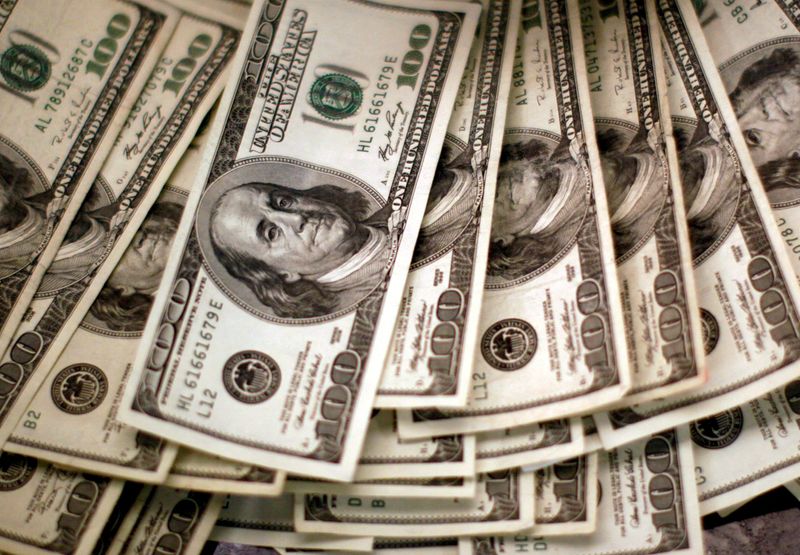Forex
Dollar tumbles to two-month low; pound hits 15-month high after wage growth data


© Reuters. FILE PHOTO: U.S. dollars are counted out by a banker counting currency at a bank in Westminster, Colorado November 3, 2009. REUTERS/Rick Wilking/File Photo
By Samuel Indyk and Gertrude Chavez-Dreyfuss
LONDON/NEW YORK (Reuters) – The dollar dropped to a two-month low against a major currency index, after Federal Reserve officials signalled that the central bank is near the end of its tightening cycle, while sterling hit a 15-month high after pay growth exceeded expectations.
Against the yen, the dollar fell to a four-week trough of 140.17. It last traded down 0.4% at 140.75 yen. The U.S. currency also plunged to its lowest in two-and-a-half years versus the Swiss franc and was last at 0.8829 francs, down 0.2%.
Several Fed officials said on Monday the central bank would likely need to raise interest rates further to bring down inflation but the end to its current monetary policy tightening cycle was getting close.
The comments knocked the greenback to a two-month low of 101.66 against a basket of currencies, as traders pared back their expectations about how much further U.S. rates may have to rise. The was last slightly down at 101.89.
“The broad takeaway from yesterday’s slate of speakers is that the Fed is essentially on auto-pilot ahead of its July meeting – and with a string of other releases set to drop between now and Jackson Hole, this has meant that the relative importance of tomorrow’s consumer price report is being downplayed on currency markets,” said Karl Schamotta, chief market strategist, at Corpay in Toronto.
Markets are now focusing their attention on U.S. consumer prices data due out on Wednesday, which will provide more clarity on the progress the Fed has made in its fight against stubbornly high inflation.
“Market participants should remember that U.S. data releases still have the capacity to shock: if the core or ‘supercore’ inflation measures surprise to the upside, front-end yields could leg higher once again, and the dollar might stage a surprising rebound,” Schamotta added.
EUROPEAN CURRENCIES STRENGTHEN
Sterling hit a near 15-month high of $1.2934 after British wage growth hit a joint record high, heaping pressure on the Bank of England to tighten policy further to bring inflation under control. It was last up 0.2% at $1.2891.
The pound has been rallying on a stronger economy and aggressive repricing of expectations for tighter BoE policy, according to Danske Bank FX analyst Kirstine Kundby-Nielsen.
The euro rose to two-month peaks of $1.1027, and last changed hands at $1.096, down 0.1%.
Other European currencies were also strong, with the Norwegian crown hitting a near three-month high the Swedish crown at a two-week peak against the dollar.
At its June meeting, the Swiss National Bank reiterated it was ready to intervene in the FX market to boost the value of the franc and reduce the effect of more expensive imports.
In Japan, the yen has risen more than 3% from a seven-month low touched last month, when it weakened past the closely watched 145 per dollar level that put traders on high alert for possible intervention from Japanese authorities.
Elsewhere, the Australian dollar eased 0.2% to US$0.6662, while the New Zealand currency was down 0.5% to US$0.6181 ahead of the Reserve Bank of New Zealand policy decision on Wednesday.
========================================================
Currency bid prices at 9:42AM (1342 GMT)
Description RIC Last U.S. Close Pct Change YTD Pct High Bid Low Bid
Previous Change
Session
Dollar index 101.8900 101.9200 -0.01% -1.546% +101.9600 +101.6600
Euro/Dollar $1.0985 $1.1001 -0.14% +2.53% +$1.1027 +$1.0977
Dollar/Yen 140.8100 141.3150 -0.35% +7.40% +141.4550 +140.1700
Euro/Yen 154.67 155.45 -0.50% +10.24% +155.6700 +154.1900
Dollar/Swiss 0.8830 0.8854 -0.27% -4.50% +0.8856 +0.8813
Sterling/Dollar $1.2899 $1.2860 +0.30% +6.66% +$1.2934 +$1.2858
Dollar/Canadian 1.3274 1.3280 -0.04% -2.03% +1.3289 +1.3246
Aussie/Dollar $0.6654 $0.6677 -0.32% -2.37% +$0.6695 +$0.6653
Euro/Swiss 0.9698 0.9737 -0.40% -1.99% +0.9753 +0.9687
Euro/Sterling 0.8514 0.8553 -0.46% -3.73% +0.8562 +0.8505
NZ $0.6170 $0.6212 -0.65% -2.80% +$0.6224 +$0.6171
Dollar/Dollar
Dollar/Norway 10.4100 10.4770 -0.73% +5.98% +10.4790 +10.4000
Euro/Norway 11.4283 11.5250 -0.84% +8.91% +11.5385 +11.4222
Dollar/Sweden 10.6845 10.7481 -0.74% +2.66% +10.7604 +10.6693
Euro/Sweden 11.7385 11.8255 -0.74% +5.28% +11.8415 +11.7266

 Forex3 years ago
Forex3 years agoForex Today: the dollar is gaining strength amid gloomy sentiment at the start of the Fed’s week

 Forex3 years ago
Forex3 years agoUnbiased review of Pocket Option broker

 Forex3 years ago
Forex3 years agoDollar to pound sterling exchange rate today: Pound plummeted to its lowest since 1985

 Forex3 years ago
Forex3 years agoHow is the Australian dollar doing today?

 Cryptocurrency3 years ago
Cryptocurrency3 years agoWhat happened in the crypto market – current events today

 World3 years ago
World3 years agoWhy are modern video games an art form?

 Commodities3 years ago
Commodities3 years agoCopper continues to fall in price on expectations of lower demand in China

 Economy3 years ago
Economy3 years agoCrude oil tankers double in price due to EU anti-Russian sanctions





















